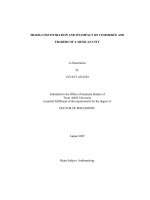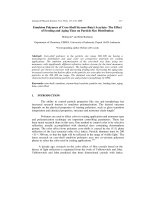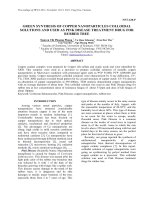Effects of capping agent concentration and reaction time on antimicrobial activities of copper nanoparticles (CUNPs)
Bạn đang xem bản rút gọn của tài liệu. Xem và tải ngay bản đầy đủ của tài liệu tại đây (9.31 MB, 86 trang )
MINISTRY OF EDUCATION AND TRAINING
HO CHI MINH CITY UNIVERSITY OF TECHNOLOGY AND EDUCATION
FACULTY FOR HIGH QUALITY TRAINING
GRADUATION THESIS
FOOD TECHNOLOGY
EFFECTS OF CAPPING AGENT CONCENTRATION
AND REACTION TIME ON ANTIMICROBIAL
ACTIVITIES OF COPPER NANOPARTICLES (CUNPs)
SUPERVISOR: TRINH KHANH SON
STUDENT: TRAN THI BAO CHAU
DONG THAO DUYEN
SKL 0 0 9 1 5 7
Ho Chi Minh City, August, 2022
n
HO CHI MINH CITY UNIVERSITY OF TECHNOLOGY AND EDUCATION
FACULTY FOR HIGH QUALITY TRAINING
GRADUATION PROJECT
Thesis code 2022-18116005
EFFECTS OF CAPPING AGENT
CONCENTRATION AND REACTION TIME ON
ANTIMICROBIAL ACTIVITIES OF COPPER
NANOPARTICLES (CUNPs)
TRAN THI BAO CHAU
Student ID: 18116005
DONG THAO DUYEN
18116007
Major: FOOD TECHNOLOGY
Supervisor: TRINH KHANH SON, ASSOC. PROF.
Ho Chi Minh City, August 2022
n
HO CHI MINH CITY UNIVERSITY OF TECHNOLOGY AND EDUCATION
FACULTY FOR HIGH QUALITY TRAINING
GRADUATION PROJECT
Thesis code 2022-18116005
EFFECTS OF CAPPING AGENT
CONCENTRATION AND REACTION TIME ON
ANTIMICROBIAL ACTIVITIES OF COPPER
NANOPARTICLES (CUNPs)
TRAN THI BAO CHAU
Student ID: 18116005
DONG THAO DUYEN
18116007
Major: FOOD TECHNOLOGY
Supervisor: TRINH KHANH SON, ASSOC. PROF.
Ho Chi Minh City, August 2022
n
n
DECLARATION
As a result, we declare that all content presented in this graduation thesis has been
carried out by us, including instructors and students. The research content is based on the
requirements, design, and guidelines and is validated by the instructor. The entire content
of the graduation thesis has been checked against plagiarism using Turnitin software,
ensuring no more than 30% duplication. We certify that regulations have correctly and
fully cited the contents referenced in the graduation thesis.
___, August 2022
Signature
i
n
ACKNOWLEDGEMENT
To complete this graduation thesis, first and foremost, we would like to thank the
Faculty of Chemical and Food Technology, University of Technical Education, Ho Chi
Minh City, for creating all conditions for equipment and facilities to help us complete the
thesis.
Moreover, we would like to thank our adored supervisor, Trinh Khanh Son, Assoc.
Prof. This paper could have never been accomplished without their assistance and
dedicated involvement in every process step. We are extremely grateful to them for
supporting and understanding us during the past time.
We are also grateful to the 2017 and 2019 students who supported us in the
research process.
With limited experience and conditions, implementing the thesis inevitably has
shortcomings. We look forward to receiving the attention and comments of teachers to
improve our report.
Our team sincerely thanks.
ii
n
iii
n
iv
n
v
n
vi
n
vii
n
viii
n
ix
n
x
n
xi
n
xii
n
xiii
n
TABLE OF CONTENTS
Chapter 1: INTRODUCTION .........................................................................................................1
1.1
Rationale………………………………………………………………………1
1.2.
Thesis objects ...................................................................................................... 1
1.3.
Limits and scope of the study .............................................................................. 2
1.4.
Research content .................................................................................................. 2
1.5.
The scientific and practical significance of the topic .......................................... 2
1.6.
Layout of the report ............................................................................................. 2
Chapter 2: OVERVIEW ..................................................................................................................3
2.1.
Overview of nanotechnology .............................................................................. 3
2.1.1. The concept of nanotechnology ...................................................................................3
2.1.2. Classification of nanomaterials ...................................................................................3
2.1.3. Applications of nanotechnology in food .....................................................................5
2.2.
Overview of copper nanoparticles ....................................................................... 6
2.3.
Introduction to copper nanoparticles ................................................................... 6
2.3.1. Methods for synthesizing copper nanoparticles ..........................................................7
2.3.2. Antibacterial mechanism of copper nanoparticles.......................................................8
2.4.
Capping agent ...................................................................................................... 9
2.5.
Escherichia coli ................................................................................................. 11
2.6.
The fungus Colletotrichum gloeosporioides ..................................................... 12
Chapter 3: MATERIALS AND RESEARCH METHODS ...........................................................15
3.1.
Materials…..…………………………………………………………………..15
3.2.
Research methods .............................................................................................. 15
3.2.1. Research diagram ......................................................................................................15
3.2.2. Synthesis method for CuNPs .....................................................................................16
3.2.3. Characteristic measurement methods of CuNPs .......................................................17
3.2.3.1. UV-VIS spectroscopy ........................................................................................17
3.2.3.2. Energy-dispersive X-ray spectroscopy (EDS) analysis .........................................17
3.2.3.3. X-ray diffraction spectroscopy (XRD) analysis ................................................17
3.2.3.4. Scanning Electron Microscope (SEM) analysis ................................................18
3.2.3.5. Transmission electron microscopy (TEM) analysis ..........................................18
3.2.3.6. Zeta potential (ZP) measurement ......................................................................19
3.2.4. Antimicrobial activity evaluation methods................................................................20
3.2.4.1. Method to determine the resistance to Escherichia coli ....................................20
3.2.4.2. Method for determining resistance to mold Colletotrichum gloeosporioides ...20
3.2.5. Data analysis method .................................................................................................21
Chapter 4: RESULTS AND DISCUSSION ..................................................................................22
4.1.
Characterization of CuNPs ................................................................................ 22
4.1.1. Optical characteristics (UV – VIS)............................................................................22
4.1.3. X-ray diffraction of CuNPs (XRD) ...........................................................................24
4.1.4. SEM, TEM and DLS .................................................................................................27
xiv
n
4.1.5. Zeta potential (ZP ) ....................................................................................................32
4.2.
Effect of capping agent (starch) concentration on antibacterial ability of nano
solution…………………………….…………………………………………………………..33
4.3.
The antifungal ability of CuNPs on Colletotrichum gloeosporioides strain ........ 36
4.4.
In vivo...………………………………………………………………………...40
Chapter 5: CONCLUSIONS AND SUGGESTIONS ...................................................................43
REFERENCES ..............................................................................................................................44
APPENDIX ...................................................................................................................................50
xv
n
LIST OF FIGURES
Fig. 2. 1. Groups of nanomaterials [17] ...........................................................................................5
Fig.2. 2. Applications of nanotechnology in all areas of food science [21] ....................................6
Fig. 2. 3. Methods for synthesizing copper nanoparticles [31] .......................................................8
Fig. 2. 4. Schematic illustration of the antibacterial mechanism of CuNPs [39] ............................9
Fig. 2. 5. Nanoparticles are covalently bonded to the capping agent[40] .......................................9
Fig. 2. 6. Types of capping agents based on the structure of the molecular chain [42] ................10
Fig. 2. 7. Anthracnose cycle in tropical fruit trees [50] .................................................................13
Fig. 2. 8. Anthracnose symptoms on some tropical fruit trees. (A) Guava, (B) dragon fruit, (C)
banana, (D) mango, (E) papaya [50] .............................................................................................14
Fig. 3. 1. Research diagram……………………………………………………………………...15
Fig. 3. 2. CuNPs synthesis process ................................................................................................17
Fig. 4. 1. UV-vis spectra of CuNPs according to different starch concentrations (%w/v) at reaction
times (A) t20, (B) t30…………………………………………………………………………….23
Fig. 4. 2. EDS of CuNPs and composition of the elements of the CuNPs are measured from the
EDS ................................................................................................................................................24
Fig. 4. 3. XRD plot of samples t20 S1,15; t20 S2,29; t20 S3,06; t30 S0,76; t30 S1,91 and t30
S2,6 ................................................................................................................................................25
Fig. 4. 4. The angled octahedron (b, c, d) and the angled cube (e) are morphological
intermediates of the octahedron (a) and the cube (f) [71] .............................................................27
Fig. 4. 5. SEM image of samples t20 S1,15; t20 S2,29; t20 S3,06; t30 S0,76; t30 S1,91 and t30
S2,67 ..............................................................................................................................................28
Fig. 4. 6. Size distribution of 100 particles from SEM images of samples t20 S1,15; t20 S2,29;
t20 S3,06; t30 S0,76; t30 S1,91 and t30 S2,67 ..............................................................................30
Fig. 4. 7. TEM image and sample size distribution (A) t20 S2,29 và (B) t30 S0,76.....................31
Fig. 4. 8. The average particle size of CuNPs according to different starch concentrations (%w/v)
at reaction time t20 and t30 by DLS method .................................................................................32
Fig. 4. 9. Zeta potential plot of CuNPs against different starch concentrations (%w/v) at reaction
times t20 and t30............................................................................................................................33
Fig. 4. 10. Resistance to E.coli according to different starch concentrations (%w/v) at reaction
times (A) t20 and (B) t30 ...............................................................................................................34
Fig. 4. 11. Presence of E.coli colonies after 48 h of plate pouring at reaction times t20 and t30 .34
Fig. 4. 12. Colony diameter of C. gloeosporioides according to incubation time at different
concentrations of CuNPs at reaction times (A) t20 and (B) t30 ....................................................36
Fig. 4. 13. The inhibitory effect on C. gloeosporioides concerning incubation time at different
concentrations of CuPs at reaction times (A) t20 and (B) t30 .......................................................37
Fig. 4. 14. Diameter of C. gloeosporioides by observation time after 3, 5 and 7 days .................39
Fig. 4. 15. Results of inhibiting the growth of C. gloeosporioides on apples after seven days of
observation.....................................................................................................................................42
xvi
n
LIST OF TABLES
Table 2. 1. The symptoms as well as the pathogenic mechanisms that are present in some E. coli
bacteria [48] ...................................................................................................................................12
Table 3. 1. Coding convention for copper nanoparticles samples in research…………………...16
Table 3. 2. Zeta potential and the stability of the colloidal [55]....................................................19
Table 4. 1. The average crystal size of nanoparticles.…………………………………………...26
Table 4. 2. The intensity ratio between (111) and (200) diffraction peaks of nanoparticles .........26
Table 4. 3. Average size of nanoparticles from SEM images ......................................................29
Table 4. 4. Average size of nanoparticles from TEM images .......................................................31
xvii
n
LIST OF EQUATIONS
nλ = 2dsinθ
(3.1) ............................................................................................................... 18
D = Kλ /cosθ (3.2) ............................................................................................................... 18
log reduced = log A1 – log A2 (3.3) ......................................................................................... 20
% Inhibition of growth =
𝐑−𝐫
𝐑
100 (3.4) ............................................................................... 21
xviii
n
%w/v
C.gloeosporioides
CFU
CuNPs
DLS
E.coli
EDS
NB
ppm
S-CuNPs
SEM
TEM
UV - Vis
XRD
ZP
LIST OF ABBREVIATIONS
Weight/volume percent
Colletotrichum gloeosporioides
Colony forming units
Copper Nanoparticles
Dynamic Light Scattering
Escherichia coli
Energy-dispersive X-ray spectroscopy
Nutrient broth
Parts per million
Starch capped Copper Nanoparticles
Scanning Electron Microscope
Transmission Electron Microscopy
Ultraviolet Visible
X-Ray diffraction
Zeta potential
xix
n
ABSTRACT
In this study, we focused on evaluating the antibacterial potential of copper(I) oxide
nanoparticles. CuNPs were prepared by chemical reduction method with copper sulfate anhydrous
as precursor and D - glucose as reducing agent in the presence of soluble starch capping agent.
The characteristic properties of CuNPs were demonstrated through various measurements such as
X-ray diffraction (XRD), UV-vis spectroscopy, scanning electron microscopy (SEM), DLS
particle size distribution, Zeta potential, and transmission electron microscopy (TEM). The results
indicated that our synthesized copper(I) oxide nano samples have high purity. Resistance to
bacteria and molds had also been observed. Overall, S-CuNPS completely inhibited the growth of
Escherichia coli and Colletotrichum gloeosporioides at a concentration of 50ppm and a
concentration of 500ppm for molds with a soluble starch content of 0.764 % (%w/v) with reaction
time was 30 minutes. Furthermore, for the in vivo antifungal assays on mangoes, the coatings
containing CuNPs inhibited fungal growth. Overall, based on the above results, S-CuNPs might
be applied as an agent to control microorganisms that form pathogen biofilms.
Keywords: S-CuNPs, characteristic, antibacterial ability, Escherichia coli, Colletotrichum
gloeosporioides
xx
n
Chapter 1: INTRODUCTION
1.1.
Rationale
Nanotechnology has had tremendous and valuable applications in electronics, energy,
medicine, cosmetics, and especially biomedicine, thanks to its ability to help humans intervene at
the nanometer scale, where nanomaterials exhibit many unique and exciting properties. The
synthesis of nano by two chemical and physical methods has been widely studied; however, the
cost of nano synthesis by some of the above methods is often very high, and the use of toxic
materials in different stages is rugged synthetic that affects human health and is not friendly to the
environment [1]. Therefore, there is an urgent need to research and develop green biological
methods to synthesize NPs.
In addition, in nanotechnology, many studies have focused on synthesizing two metals,
gold and silver, but there are few studies on synthesizing CuNPs, especially green synthesis. With
cheap synthesis cost, ease of use, large-scale application, and outstanding properties, especially
antibacterial properties similar to precious metals, CuNPs have been and are being researched by
manufacturers and researchers. Not only that, in solutions, bare nanoparticles are
thermoelectrically unstable and tend to aggregate, losing their specific properties. Therefore,
investigating different types of coatings for nano synthesis is also of interest to researchers.
Typically, the research of [2] has successfully synthesized copper (I) oxide nanoparticles with the
smallest particle size of 222 ± 13 nm, with the use of reducing agent, glucose, and polyvinyl
alcohol (PVA) encapsulation showed the results that copper (I) oxide nanoparticles had the highest
ability to kill E. coli at a concentration of 160 ppm with a treatment time of 1 hour and a pH value
of 8.0. Recently, [3] demonstrated antibacterial and antifungal activity of copper oxide/carbon
(CuO/C) nanocomposites against Pseudomonas aeruginosa, Escherichia coli, Klebsiella
neumonia, Staphylococcus aureus, Candida albicans, and Aspergillus niger.
On the other hand, following the progress of science and technology, finding more optimal
preservation methods for agricultural products such as fruits is receiving much attention, including
the research direction of biopolymer films, the most prominent being edible films. With those
mentioned superior antibacterial properties of CuNPs, along with the constant increase of
pathogenic bacteria that threaten the lives of humans and other organisms, the research and
application of CuNPs in life is significant and is a new and urgent direction. For the above reasons,
we decided to choose the research topic with the research content “Effects of capping agent
concentration and reaction time on antimicrobial activities of copper nanoparticles (CuNPs)”
1.2.
Thesis objects
In this study, copper(I) oxide nanoparticles were synthesized by chemical reduction, using
copper sulfate anhydrous as a precursor, D-Glucose as a reducing agent, and starch as a capping
agent. We focused on investigating the factors affecting the antibacterial ability of copper
nanoparticle solutions, such as reaction time, the concentration of capping agent (starch), and
storage conditions. From there, find the conditions for synthesizing nano copper with the most
optimal antibacterial ability.
1
n









